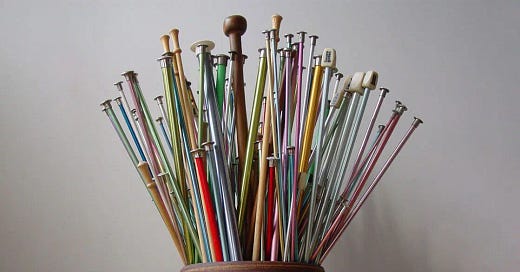The yarn often takes the spotlight when knitting, leaving knitting tools in the background. However, the types of tools you use can also significantly impact the environment. Fortunately, there are sustainable alternatives to commonly used plastic tools that are eco-friendly and add a touch of luxury to your knitting experience. This article focuses on needles, but it applies to any other gadget we have at home: sock blockers, gauge squares, cable needles, stitch holders, binders, and many others… knitters accumulate tons of needles and mini-tools. Remember to keep in mind that the longer you use a tool, the more you reduce its environmental fingerprint.
The Problem with Plastic
Plastic knitting needles and accessories are popular due to their low cost and lightweight nature. But they are not necessarily more durable as they can be quite fragile, and the environmental cost of producing and disposing of plastic tools is alarmingly high. Most plastic items take hundreds of years to decompose, leading to landfill clutter and ocean pollution.
Bamboo: A Renewable Resource
One of the most sustainable choices for knitting needles is bamboo. Bamboo is a renewable resource that grows rapidly, making it an eco-friendly option. These needles are incredibly durable and can last long if taken care of properly. Additionally, many knitters find that bamboo needles offer better grip than their plastic counterparts, making it easier to handle slippery yarns.
Wood: A Touch of Luxury
Wooden needles, often made from birch or rosewood, are another sustainable option. It would be awesome to know from the manufacturers if the wood comes from responsibly managed forests, though this information is not widely available. Wooden needles are beautiful and warm and can make your knitting experience more enjoyable. However, choosing brands certifying their wood as sustainably sourced is crucial.
Stainless Steel Needles: Built to Last
Stainless steel needles might not come to mind immediately when you think of sustainability, but their extreme durability makes them an excellent choice for the environmentally conscious. The long lifespan of stainless steel needles means you won't have to replace them as often, reducing waste. They're also perfect for those who prefer a slicker, faster knitting surface.
Upcycled and Vintage Tools
Another way to approach sustainability is by using upcycled or vintage knitting tools. These are often available at thrift stores, estate sales, or even in your grandmother's old sewing kit. Using what already exists is a great way to minimize waste.
The Benefits Extend Beyond the Environment
Switching to sustainable knitting tools is not just good for the Earth but also beneficial for you. Sustainable materials like bamboo and wood are generally more pleasant to hold for extended periods, reducing the likelihood of hand fatigue. Their natural textures provide better grip, allowing for more control as you knit.
Switching to sustainable knitting tools is a small but meaningful step towards a more eco-friendly lifestyle. By choosing long-lasting and sourced tools responsibly, you're contributing to a less wasteful and more sustainable world—one stitch at a time.
Finally, if you are not using it anymore, before you through it out, give it away! One man’s trash is another man’s treasure. Contribute to the circular life of your tools.
Click here to read more about sustainability in knitting.
—written by Esperanza Rivera de Torre
Read more
You can access all our articles at KnitLeaks.com





Hi!
KnitPro uses renewable sources.
https://www.knitpro.eu/sustainability/en
Hi Ezperanza, what brands do you recommend that sell wooden needles from sustainable sources?